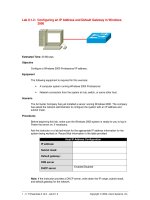03 ip address 2
Bạn đang xem bản rút gọn của tài liệu. Xem và tải ngay bản đầy đủ của tài liệu tại đây (2.73 MB, 46 trang )
IP ADDRESS CLASSES
IP network address
• Network layer addresses are 32 bits
long.
• The are presented as four octets in
dotted decimal format.
• The IP address has two components:
Network ID and Host ID.
IP address format
Binary and decimal conversion
Fast conversion
Network ID and host ID
• Network ID :
– Assigned by Internet Network Information
Center.
– Assigned by upper organization.
– Identifies the network to which a devices is
attached.
• Host ID :
– Assigned by a network administrator.
– Identifies the specific device on that
network.
Bits on the IP address
• Network Bits :
– Identifies network ID
– Identifies class of the IP address
– All of bits are 0: not allowed
• Host Bits :
– Identifies host ID
– All of bits are 0: reserved for network
address
– All of bits are 1: reserved for broadcast
address
IP address classes
• Different class addresses reserve
different amounts of bits for the Network
and Host portions of the address
• Provide the flexibility required to
support different size networks
IP address classes: Class A
IP address classes: Class A
• The first bit of a Class A address is
always 0.
• The first 8 bits to identify the network
part of the address.
• Possible network address from 1.0.0.0
to 127.0.0.0.
• The remaining three octets can be used
for the host portion of the address.
• Each class A network have up to
16,777,214 possible IP addresses.
IP address classes: Class B
IP address classes: Class B
• The first 2 bits of a Class B address is
always 10.
• The first two octets to identify the
network part of the address.
• Possible network address from 128.0.0.0
to 191.255.0.0.
• The remaining two octets can be used
for the host portion of the address.
• Class B network have up to 65.534
possible IP addresses.
IP address classes: Class C
IP address classes: Class C
• The first 3 bits of a Class C address is
always 110.
• The first three octets to identify the
network part of the address.
• Possible network address from 192.0.0.0
to 223.255.255.0.
• The remaining last octet can be used for
the host portion of the address.
• Class C network have up to 254 possible
IP addresses.
IP address classes: Summary
• 1.0.0.0 - 126.0.0.0 : Class A.
• 127.0.0.0 : Loopback network.
• 128.0.0.0 - 191.255.0.0 : Class B.
• 192.0.0.0 - 223.255.255.0 : Class C.
• 224.0.0.0 < 240.0.0.0 : Class D, multicast.
• >= 240.0.0.0 : Class E, reserved.
Network address
• Network address provide a convenient
way to refer to all of the addresses on a
particular network or subnetwork.
• Two hosts with differing network
address require a device, typically a
router, in order to communicate.
• An IP address that ends with binary 0s
in all host bits is reserved for the
network address.
Broadcast address
• Broadcast goes to every host with a
particular network ID number.
• An IP address that ends with binary 1s
in all host bits is reserved for the
directed broadcast address.
• An IP address with binary 1s in all
network bits and host bits is reserved
for the local broadcast address.
Local broadcast address
STOP
255.255.255.255
Directed broadcast address
192.168.20.0
192.168.20.255
Broadcast address
Example: 172.16.20.200
• 172.16.20.200 is Class B address
• Network portion:
172.16
• Host portion:
20.200
• Network address:
172.16.0.0
• Broadcast address: 172.16.255.255
Private addresses
• According to RFC-1918.
• Organizations make use of the private
Internet address space for hosts that
require IP connectivity within their
enterprise network, but do not require
external connections to the global
Internet.
• Class A: 10.0.0.0.
• Class B: 172.16.0.0 - 172.31.0.0.
• Class C: 192.168.0.0 - 192.168.255.0.
SUBNETTING
AND
CREATING A SUBNET
Why we need to divide network?
• Network administrators sometimes need
to divide networks, especially large
ones, into smaller networks:
– Reduce the size of a broadcast domain.
– Improve network security.
– Implement the hierarchical managements.
• So we need more network addresses for
your network. But I want the outside
networks see our network as a single
network.
Divide network by three
Subnetting
• Subnetworks are smaller divisions of
network.
• Subnet addresses include the Class A,
Class B, or Class C network portion,
plus a subnet field and a host field.
• To create a subnet address, a network
administrator borrows bits from the
original host portion and designates
them as the subnet field.
• Subnet addresses are assigned locally,
usually by a network administrator.









